Goldenseal (Hydrastis canadensis) is a North American botanical icon! This potent root has been a staple in Indigenous medicine, a prized trade good in early American herbalism, and a go-to for immune support and gut health in modern wellness.
What makes goldenseal so special? It’s all about the plant’s natural alkaloids, berberine and hydrastine, two potent compounds that give this herb its signature bitter kick and serious wellness boost. From fortifying your immune system and tackling seasonal sniffles to keeping your gut in check, goldenseal is the kind of herb you want in your toolkit for when you need to pull out the big guns!
So, what’s the best way to use it? How do you get the most out of its benefits without overdoing it? We'll dive into goldenseal’s rich history, health perks, best uses, safety tips, and even a simple DIY recipe to bring this herbal powerhouse into your wellness routine.
Botanical Background

Goldenseal is a remarkable herb with a rich history and incredible medicinal value. Appreciating the medicinal plant goldenseal and its origins helps us understand the importance of protecting this plant for future generations!
Goldenseal (Hydrastis canadensis) belongs to the Ranunculaceae family (also known as the buttercup family). It is native to the shady, rich woodlands of Eastern North America, where it thrives in its natural habitat. However, due to over-harvesting and habitat loss, it is now endangered in many states. Its always important to sustainably source and harvest herbs so we can pass these medicinal gems down for generations to come.
Key Features of Goldenseal
-
Physical Description: A low-growing perennial with fuzzy, lobed leaves that resemble raspberry foliage. It produces a bright red berry in summer (non-edible) and its prized feature is the golden-yellow, knobby rhizome underground, packed with its medicinal properties.
-
Conservation Status: Sustainability is critical for protecting goldenseal. Choosing cultivated sources rather than wild-harvested plants helps preserve this valuable herb for generations to come.
Goldenseal’s story also reminds us of the delicate balance between nature and human use. As we benefit from this plant’s healing properties, we have the opportunity to support conservation efforts and explore innovative ways to cultivate and protect goldenseal may other endangered species. By doing so, we ensure a healthier future for both people, the planet, and the beneficial metabolic effects of goldenseal.
Goldenseal Through the Ages: A Healing Herb with a Rich History
Goldenseal’s reputation as a healing herb is centuries old. It may be trendy now, but its historical uses show how valuable it has always been.
Native American Medicine
Indigenous tribes, particularly the Cherokee, Iroquois, and Kickapoo, recognized goldenseal’s healing potential and used it extensively for immune and digestive support, wound healing (often applied as a poultice), supporting eye health, and as a natural dye for fabric and face paint. This ancestral knowledge laid the groundwork for how we use goldenseal today.
Colonial America & the Eclectic Medicine Movement
European settlers quickly learned about goldenseal from Indigenous peoples. By the 19th century, it became a star ingredient in the Eclectic Medicine Movement, supported by holistic practitioners who preferred botanical remedies.
From 1830 to 1960, goldenseal’s medicinal properties earned it a place in the U.S. Pharmacopeia, commonly used as an immune booster and digestive tonic due to its microbial balancing properties.
Modern-Day Use
Today, goldenseal is a popular herbal remedy for immune support, digestive health, skin care, respiratory relief and overall lung health.
It’s often paired with echinacea or other immune supportive herbs for seasonal support.
Health Benefits & Medicinal Properties
Goldenseal has long been cherished for its impressive medicinal uses. Its power comes from three active alkaloids—berberine, hydrastine, and canadine—which work together to provide a range of health benefits. Let’s take a closer look at how this herb can improve your well-being.
Goldenseal and its active component, berberine, may affect blood sugar and both blood pressure levels. Berberine can lower blood sugar by increasing insulin sensitivity and blocking glucose absorption. However, caution is advised when using goldenseal alongside diabetes medications due to possible interactions.
1. Immune System Support
When it comes to keeping your immune system strong, goldenseal is a go-to! Its unique properties help your body defend itself against common threats.
-
Supports healthy white blood cell balance to enhance your natural defenses.
-
Microbial balancing properties helps fight off "bad" bugs that can enter your system.
-
Helps maintain healthy mucous membranes in the respiratory system.
-
Often paired with echinacea for a synergistic immune-boosting effect.
Goldenseal gives your immune system a powerful boost when you need it most. Its perfect for short-term support when symptoms are acute.
2. Digestive Health & Gut Balance
Your digestive system plays a critical role in overall health, and goldenseal steps in when your digestive tract needs swift support. With its bitter alkaloids and gut-balancing properties, this herb is a valuable ally for gastrointestinal wellness.
-
Promotes gut health by supporting a balanced microbiome.
-
Enhances digestion by supporting healthy enzyme and bile production.
-
Soothes the inflammatory response and eases discomfort in the digestive tract.
-
Relieves common digestive issues like bloating and indigestion.
-
Supports overall digestive efficiency, ensuring optimal nutrient absorption.
Goldenseal ensures your digestive system works smoothly, which can have a ripple effect on your energy and overall vitality.
3. Skin & Wound Healing
Goldenseal isn’t just for internal health, it’s also a fantastic remedy for skin issues. Its microbial balancing properties make it ideal for supporting healthy healing and clearer skin.
-
Aids in healing minor cuts, scrapes, and wounds when used topically.
-
Helps soothe redness and skin irritation.
-
Supports a healthy skin microbiome.
-
Supports a healthy looking complexion and a natural glow.
Goldenseal is a go-to herb for addressing skin concerns, offering gentle care for both cosmetic and medicinal needs.
Sinus & Upper Respiratory Tract Support
Struggling with sinus pressure or respiratory discomfort, or concerned about chronic lung discomfort? Goldenseal can help! Its astringent and immune supportive properties work together to provide relief.
-
Eases congested sinuses and clears excess mucus.
-
Tones mucous membranes for improved respiratory health.
-
Eases symptoms of post-nasal drip and seasonal allergies.
By keeping your respiratory system clear and healthy, goldenseal helps you breathe easier and feel more comfortable, no matter the season.
6. Women’s Health Support
Goldenseal tea has been a trusted remedy for women’s health for generations. Its ability to balance natural flora makes it especially helpful for specific female health concerns.
-
Supports vaginal health by promoting balanced flora.
-
Traditionally combined with cranberry or uva ursi for urinary tract health.
-
Helps manage discomforts naturally.
Beyond these benefits, goldenseal’s versatility makes it a great addition to any woman’s wellness routine, supporting overall balance and vitality.
How to Use Goldenseal
Goldenseal is known for many health benefits, but like all potent remedies, it’s important to use it wisely. Overuse or long-term consumption can disrupt your gut flora, so it’s best to incorporate it into your routine thoughtfully and sparingly. Goldenseal works fast, so its best to use acutely and short-term.
As with all dietary supplements, it is crucial to adhere to safety and dosing guidelines and consult a professional to avoid potential health implications. If you’re new to goldenseal, here are some of the most common forms and ways to include it in your herbal regimen.
Common Forms of Herbal Supplement
-
Tinctures (liquid extracts) - Fast-acting and potent.
-
Capsules or Tablets - Convenient for precise doses.
-
Tea or Infusions - Perfect for digestion and immune support, despite its bitter taste.
-
Topical Washes or Salves - Ideal for external use on cuts, scrapes, or skin conditions.
Always consult a healthcare professional before adding new herbs to your routine, especially if you’re pregnant, nursing, or taking medication.
With mindful use, goldenseal can support your health journey effectively and naturally. When selecting goldenseal supplements, ensure they are ethically sourced and verified by independent testing to avoid adulteration with other herbs.
The Power of Liquid Herbal Extracts
Why choose liquid herbal extracts over other forms? These concentrated tinctures offer several advantages that make them a superior choice for herbal supplementation:
-
Fast-Acting Benefits: Liquid extracts bypass the digestive process required for breaking down pills or capsules, allowing for quick absorption directly into your bloodstream.
-
Superior Absorption: Your body can absorb liquid herbs more efficiently than solid forms, making more of the beneficial compounds available for use.
-
Easy to Customize: Liquid extracts are simple to adjust for your needs.
-
Long Shelf Life: When properly stored, liquid herbal extracts maintain their potency for extended periods.
Synergistic Herb Combinations
Goldenseal works even better when paired with complementary herbs:
-
Echinacea - Boosts immune support and helps the body fight off bugs and the common cold.
-
Oregon Grape Root - Promotes digestive health and supports a healthy gut.
-
Cranberry & Uva Ursi- Enhances urinary health and helps maintain urinary tract balance.
-
Marshmallow Root - Soothes and hydrates tissues, offsetting the drying effects of Goldenseal.
Pairing goldenseal with complimentary herbs creates a balanced herbal blend that supports your body in addressing multiple symptoms.
Safety & Precautions
Goldenseal’s potency demands respect. Use it with care:
-
Avoid long-term use - Extended use can disrupt gut flora and deplete essential B vitamins, impacting overall gut health.
-
Not safe during pregnancy or breastfeeding - It may stimulate uterine contractions, posing risks to both mother and baby.
-
May interact with medications - Be cautious, especially if you’re taking antibiotics or drugs processed by the liver. Berberine, a compound in goldenseal, can affect major human hepatic cytochrome enzymes, leading to potential interactions with liver enzymes. Consult a healthcare provider if unsure.
-
Not for daily immune boosting - Goldenseal is most effective when used during active illness, not as a regular supplement.
[[ recipeID=recipe-2m8ytpv1f, title=Goldenseal-Infused Honey for Immune Support ]]
Harness the Power of Goldenseal
Goldenseal isn’t your everyday herb, but is a trusted and potent plant best saved for when you really need it. Whether you're looking for immune support or digestive balance, this botanical heavy-hitter has your back. But remember, with great herbal power comes great responsibility! Goldenseal works best when used strategically, so check in with your healthcare provider before adding it to your routine, especially if you're on medications.
How WishGarden Uses Goldenseal

At WishGarden, we believe in using goldenseal where it shines, providing powerful, short-term support when your body needs it most. We pair this potent herb with other immune and respiratory allies to create targeted formulas designed to help you bounce back fast. You’ll find goldenseal in the following formulas:
-
Get Over It! – Your go-to for recovery support so you can get back to feeling like yourself.
-
Kick-Ass Biotic – Helps your body stand strong when exposed to seasonal or travel-related challenges.
-
Kick-Ass Immune – Take at the first sign of feeling off to help your body fight back fast.
-
Kick-Ass Sinus – Opens up nasal passages and supports clear, easy breathing in minutes.
-
Serious Cough – Soothes a stubborn cough so you can finally catch a break.
-
Serious V-Fighter – Supports immune balance, body comfort, and a healthy temperature when you need it most.
Herbalist Q&A: Goldenseal
Is goldenseal hard on the liver?
Goldenseal is generally well-tolerated for short-term use, but because it contains berberine, it may influence liver enzymes and interact with medications processed by the liver. While it’s not known to cause liver damage in healthy individuals, prolonged use may put strain on liver function. If you have a liver condition or take medications that rely on liver metabolism, consult your healthcare provider before use. To support safe use, stick to short-term applications—typically no more than 10 days at a time.
Are turmeric and goldenseal the same thing?
Nope! Turmeric (Curcuma longa) and goldenseal (Hydrastis canadensis) come from different plant families and have distinct benefits. Turmeric is a golden-hued root known for its free radical scavenging and inflammatory-balancing properties, thanks to curcumin. Goldenseal, on the other hand, is a bitter, berberine-rich herb prized for its immune and digestive support. Both are powerful, but they work in totally different ways.
Can I take goldenseal every day?
Goldenseal isn’t meant for daily use. It’s more of a “use when needed” kind of herb. Because of its affinity for the microbiome, long-term use may disrupt gut flora. Herbalists recommend using goldenseal strategically, typically for no more than 10 days at a time, to support your body during temporary challenges. For everyday immune support, consider gentler options like astragalus or medicinal mushrooms.
Does goldenseal work like an antibiotic?
Goldenseal contains berberine, a natural plant compound with properties that influence the microbiome, but it’s not a direct substitute for prescription antibiotics. While berberine can help maintain microbial balance and support the body's natural defenses, it doesn’t have the same broad-spectrum effects as pharmaceutical antibiotics. Goldenseal is best used as part of a holistic approach to immune and digestive wellness.
Rebecca Younger is passionate about herbs and women's health. She aspires to plant seeds of inspiration within her community about plant medicine and healthier ways of life. She studied Herbal Medicine at Herbalism Roots in Denver and is a certified Doula through the Matrona Foundation. She is the Brand Communications Specialist at WishGarden Herbs.
For educational purposes only. This information has not been evaluated by the Food and Drug Administration. This information is not intended to diagnose, treat, cure, or prevent any disease, or to sell any product.
Recommended Products
Further Reading














